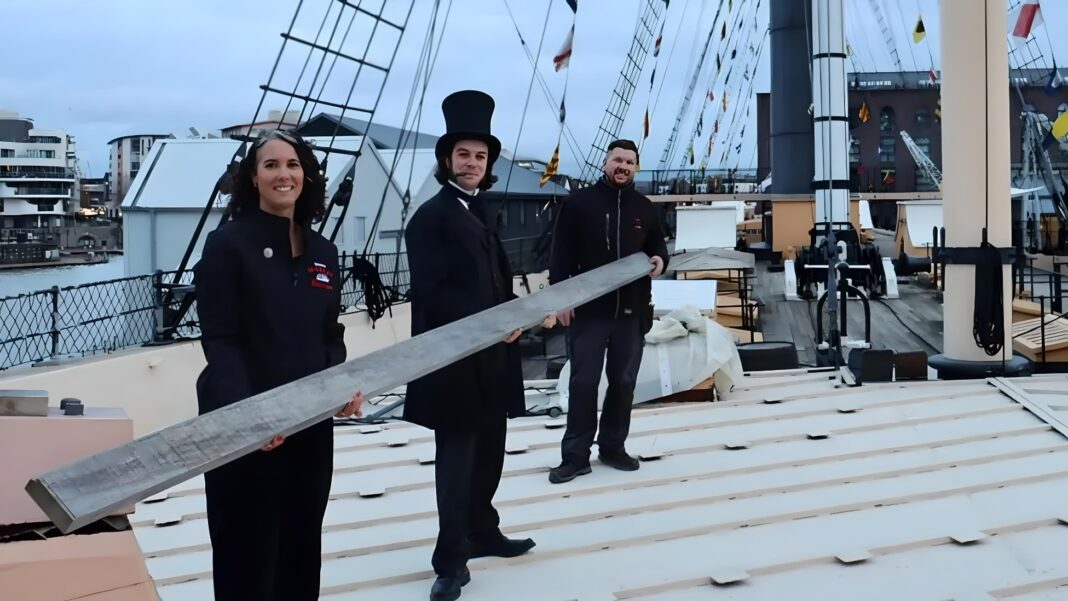The deck of the world’s first great ocean liner is undergoing a massive refurbishment in a project backed by the Arts Council England and the SS Great Britan Trust that will extend the ship’s life by 50 years.
Wood Central understands that accoya timber planks will replace the existing Jarrah used across the 98-metre deck of the SS Great Britain, protecting the original ironwork under the deck.
Described by West of England mayor Dan Norris as “stunning” with the SS Great Britan Trust confirming that the accoya wood was a “more historically authentic brown colour” and “more ship resistant.”
The work began in December, is expected to be completed in the UK summer and will be delivered in small sections to allow visitors to explore the ship from its Bristol base.
Yesterday, the first phase of the project was delivered in time for the 218th birthday of its famous designer, Isambard Kingdom Brunel, who launched the famous ship in 1843.
During its time at sea, the SS Great Britain welcomed more than 30,000 passengers and crew on the weather deck, including the first-ever English cricket team to tour Australia in 1862.
At its launch, it was the largest ship in the world and the first screw-propelled, ocean-going, wrought iron ship – used extensively for luxurious Anglo-American passenger travel.
According to Mike Day, Senior Project Manager for SS Great Britan, the project team will “gradually lift the old timbers, piece by piece.”
The SS Great Britain navigated the world 32 times, covering more than a million miles at sea. “As it’s been 33 years since the current deck was installed, we’re not sure quite what we’ll find below,” Mr Day told the BBC in December.
“The steel deck beneath the wood provides vital protection of the fragile 180-year-old iron hull and should be in pretty good condition, but any necessary repairs to it will be undertaken at the same time.”
“What’s more, [visitors] be able to get up close to see the deck works taking place, with opportunities to find out more about real-life conservation in action with special behind-the-scenes glimpses.”

The timber, which comes from locally based timber merchant Robbins Timber, “provides the optimum lifespan with the deck expected to remain in place for at least 50 years,” according to Mike Lewis, the Technical Sales Manager for Accsys Technologies, who supplied the timber.
“With over 150,000 visitors annually, the Trust needed a highly stable and hard-wearing material while maintaining an authentic look and feel.” He said the material’s durability and stability make it an ideal fit for this purpose.
“Its resistance to shrinkage and swelling will protect the iron hull from water damage and minimise maintenance for the Trust.”
Accoya wood is ideal for boat decks, trimmings and freshwater applications like canal linings with the FSC-certified wood, leading to a waterproof deck that “will improve conservation efficiencies and protect the original ironwork,” Mr Day said.

According to Nerys Watts, Head of External Affairs for SS Great Britan Trust, the conservation work, possible thanks to funding from Arts Council England’s Museum Estate and Development Fund, is crucial in protecting the heritage of the 180-year-plus ship.
“The Weather Deck is essentially the ‘roof’ to the fragile original iron hull built in Bristol in 1843.”
“We are incredibly grateful to Arts Council England and DCMS for their crucial support as this major conservation work helps to protect the SS Great Britain for many decades to come.”
“It’s not only a vital conservation project, but will also allow continued wheelchair and step-free access to every area of the ship.”
“Enabling people to access the deck and interact with a 180-year-old ocean liner that changed the world brings stories of innovation and global migration to life.”
“The fact that we can do that while also showcasing real-life conservation in action in front of visitors to the deck works particularly well.”






